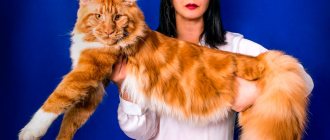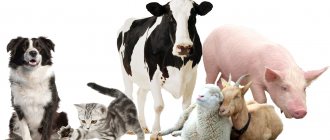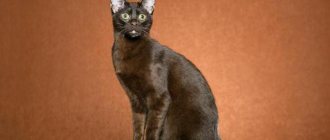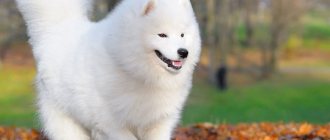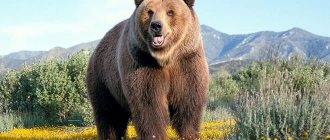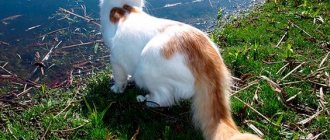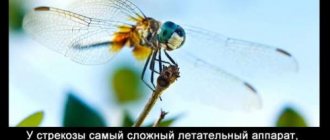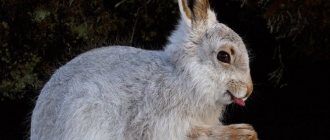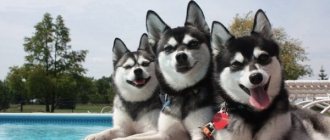Mini collies (also called shelties) are not just dogs with beautiful appearance, but real intellectuals. It’s not for nothing that they take 6th place in the list of the smartest animals. Shelties have earned special love among dog breeders due to their kindness, affection and activity.
Mini collie is a cheerful friend and a great companion
Maintenance, care, nutrition
The Little Collie has a long, straight hair shaft and a thick undercoat.
Due to this physiological feature, the coat of these animals requires constant care and combing. It is recommended to carry out the procedure at least once a week using a special comb, which can be purchased at any pet store. This will help avoid unpleasant consequences in the form of tangles that will have to be cut off. It is recommended to wash dogs infrequently, because even a specially selected shampoo will lead to dry skin and dandruff. No special eye care is required. To maintain the normal appearance of the coat and maintain shine, add a special vitamin complex to your dog’s diet. Vitamins can be purchased independently at a veterinary clinic or pharmacy. Try to choose a combination that is suitable for caring for the outer skin and strengthening teeth and claws.
Visit your dentist every 2-3 years or as needed for a teeth cleaning. This will help get rid of such annoying consequences as tartar, inflammation of the gums, unpleasant odor from the mouth and will keep your pet’s teeth in appropriate condition for a longer time.
Due to its small size, it is possible to keep a miniature collie in an apartment, but be prepared for the fact that the dog may bark loudly for no reason and will cause some discomfort to the neighbors. Therefore, the best option for keeping it would be a country house with a large outdoor space for active games and training.
Once every 10–12 days, add milk to your pet’s usual diet. Milk is a source of calcium necessary to strengthen bones and teeth. Despite their small size, Shelties love to eat hearty food. Obesity is often recorded in representatives of this breed. Follow the diet and do not add food in cases where your pet empties one bowl after another. Believe me, he is full, he just doesn’t feel the measure.
How to choose a mini collie puppy
When purchasing a kitten from an official shelter or from breeders, pay attention to the presence of a complete list of documents: veterinary card, stud book, license. The veterinary record should contain mention of the first vaccinations performed.
The animal must be washed and clipped before purchasing. It is advisable to decide on the gender and color immediately before purchasing.
Pay attention to the conformity of color and height to the standards. Remember, there are only four main colors and the height at the withers does not exceed 35 cm
Among other things, visually inspect the condition of the mucous membranes and skin. Pay attention to the puppy's temperament and character. Healthy dogs should be active and playful and show interest in new people. Be wary of individuals who are apathetic, lethargic, showing signs of disease, or excessive thinness.
When buying a baby “from hand” and lacking a veterinary book, ask the previous owner about vaccinations, condition, activity, and appetite. Take a closer look at the ears. In this breed, in the early stages, the ears acquire an erect position, directed forward, and are relatively small in size. Hanging ears at two months of age are a sign of abnormality.
Possible diseases and methods of treating them
Shelties have strong immunity. They move a lot and therefore hardly get sick. However, some representatives of the breed still end up at the veterinarian. Possible diagnoses:
- Hip dysplasia. Often diagnosed as a mature Sheltie.
- Allergy to food. Occurs only when the animal is not fed properly.
- Epilepsy. Congenital pathology, often found in males.
If your pet constantly scratches its eyes or ears, it may have an infection. After a medical examination, you will have to instill a special medicine into his mucous membranes. You cannot prescribe it yourself!
Remember, healthy Shelties are active, lively and curious. It is easy to understand that the dog is sick. Firstly, she will sleep a lot, and secondly, she will lose her appetite. In this case, take her to the vet.
Prices for puppies
There are kennels specializing in breeding dogs of this breed. The cost of a puppy depends on whether it will be possible to take part in exhibitions and on its pedigree. As a rule, the cost of puppies of different colors does not differ significantly.
The average cost of high-class puppies is 50 thousand rubles, and without a pedigree or with a non-standard color - 13-15 thousand rubles. In general, the price range is from 25 to 35 thousand rubles.
When choosing a puppy you need to be careful: too low a price should alert you.
When comparing Collies, it must be taken into account that these two breeds have only external similarities. They came from different ancestors and lived in other territories and cannot be approached with a common yardstick. The standard for the colors of the Scottish Sheepdog Collie differs significantly.
Education and training
The key to proper upbringing and productive training is a strong relationship with the owner. Shelties absolutely cannot tolerate physical violence being used against them, so being rude is prohibited. It is enough to point out mistakes with your behavior and praise if the dog follows the command correctly.
It is especially important to teach your pet the following commands:
- "Ugh".
- "Quiet".
- "Voice".
- "It is forbidden".
- "To me".
Important! For training to be effective, you should treat your pet with treats for correctly executed commands.
Origin story
There is no reliable information about when and by whom the first Sheltie dogs were bred. But among dog handlers, the two most plausible versions are in circulation:
In addition, experts suggest that the Sheltie gene pool was formed with the participation of King Charles Spaniels and other continental breeds. The time frame for the formation of the species is outlined by the 9th–14th centuries.
The main purpose of the dogs was shepherding service. The small, but nimble Scottish Sheepdog Sheltie skillfully coped with the rutting sheep, deftly urging animals that lagged behind the flock. However, in the 19th century, British breeders developed new, larger varieties of livestock. The intelligent, but almost dwarf Sheltie dog could do little to oppose the massive sheep, except for a ringing bark and light biting. As a result, the herd did not listen and wandered randomly.
Miniature dogs were replaced by large types of shepherd dogs, and the Sheltie breed fell out of favor. The population was rapidly thinning, almost on the verge of extinction. Local enthusiasts, led by experienced breeder James Loggie, decided to save the Shetland dogs. By that time, Shelties began to be kept as ordinary pets, and it was decided to make excellent home companions out of the former shepherds. To do this, they tried to standardize the species of individuals, endowing the offspring with selected genes.
They wanted to call the revived breed Shetland Collies, but Scottish Collie breeders opposed this decision.
Due to the similarity of names, there could be confusion in the breeds, so we had to take the indignation of our colleagues into account. Based on its main habitat and in honor of its original purpose, the updated species was named Shetland Sheepdog or Sheltie for short.
The population began to grow, which was facilitated by the creation of the Scottish and English Sheltie clubs (1909 and 1914). Around the same time, several representatives of the breed were exported overseas, and in America, mini collies instantly won the sympathy of the public. And after another couple of decades, the breed achieves the honor of being officially recognized. In 1948, the English Club created a standard description of the breed for Sheltie, which would later be used as a basis by other cynological federations.
Mating
Dogs over 18 months old are allowed to breed. In females, as a rule, this is the third sexual heat. The first estrus occurs at the age of 6 to 9 months , depending on the characteristics of the body.
Shelties are bred on the 10th – 12th day of estrus – these are approximate data. Ovulation can occur on the 15th – 18th day of sexual heat, because these are living organisms, it is impossible to accurately predict. A dog does not need to select a time for mating.
Shetland Sheepdogs have a very wide range in the number of puppies per litter. One female can bear 3 - 4 puppies , the other safely gives birth to 6 - 7 .
Before mating, it is recommended that the dog and bitch undergo deworming in order to prevent infection of the offspring.
Read a detailed article on the topic: “Everything you need to know about breeding dogs: appropriate age, what to do if it doesn’t work out, rules and tips.”
History of the breed
The exact origin of this breed is unknown, but there is no doubt that the birthplace of the breed is the British Isles. Ancient images of black and tan short-legged small dogs, very similar to the Lancashire Heeler, found in Wales and England suggest the ancient origins of the breed. The period of active restoration of the breed occurred in the 1960-1970s, when, by crossing the Welsh Corgi and the Manchester Terrier, enthusiasts aimed to recreate a short, compact dog with outstanding herding abilities. After the official recognition of the breed by the English Kennel Club in 1981, the breed became available to a wide range of lovers. They were originally used as herding dogs, but nowadays they are increasingly becoming companions or pets.
The Fédération Cynologique Internationale recognized the breed on a provisional basis on May 1, 2016.
Kinds
The Sheltie breed was standardized once, so its varieties are not distinguished. However, these wonderful shepherd dogs can be classified by color. Possible options:
- Black-red-white (more common than others).
- White black.
- Blue-red-white (blue morel).
- Sable.
High-breed representatives are united by the presence of a large white spot on the sternum. There may also be light markings on dogs' paws and faces. Their presence in these areas is preferable. But reddish-brown spots on the Sheltie’s body are extremely undesirable.
Life expectancy and health
Such dogs live for about 4-5 years, sometimes even less, but this is provided that they do not receive proper care and attention. Dwarf dogs require a special approach.
Due to problems at the hormonal level, they are prone to many diseases:
- Diseases of the skin, mucous membranes;
- Diseases of the internal organs, in particular the kidneys and digestive organs - they have a normal shape, characteristic of the German Shepherd, in contrast to the reduced skeleton;
- Miniature Shepherds suffer from bone and joint disease;
- Prone to food allergies;
- Dogs have eye problems;
- Thyroid diseases and susceptibility to infections.
All diseases of dwarf pets are easy to identify and diagnose, the main thing is not to neglect the health of your animal.
Features of feeding and diet
When choosing industrial food, you should give preference to super-premium brands. As for natural feeding, the diet should consist of three components: proteins, carbohydrates and fats.
You can feed your dog the following foods:
- lean meat;
- sea fish;
- cottage cheese and kefir;
- cereals;
- vegetables.
Important! If individual intolerance to a certain product is detected, it must be excluded from the animal’s diet.
Origin story
It’s hard to imagine, but the homeland of these extraordinary dogs, which can sometimes be found on Russian streets, is distant Scotland. It was to the Shetland Islands several hundred years ago that the distant ancestors of these dogs arrived on ships of settlers from the mainland. These animals were used to help shepherds, guard and walk animals. The fertile Scottish vegetation and spacious mountain valleys have become ideal pasture for raising small livestock: sheep and goats.
For example, with Spitz dogs, from which these dogs received a soft and fluffy coat, as well as a variety of colors. Over time, these shepherd dogs began to be deliberately crossed with representatives of other breeds in order to inherit certain external or physical qualities. According to some sources, the following dog breeds participated in the formation of the Sheltie breed: border collies, King Charles spaniels, Schipperkes, Icelandic and Greenlandic shepherd dogs.
Initially, the Sheltie's ancestors were used exclusively for herding - their small size allowed these dogs to freely and quickly manage medium-sized herds of sheep. Shelties not only monitored the stray sheep, but also helped drive the entire herd at the end of the working day from the grazing area to the paddock, and loudly barked to inform the shepherds about the arrival of the herd.
Shelties were the ideal herding dog for the Scottish lands - they had a light but strong body and strong legs that allowed them to move quickly through even the most difficult terrain. In addition, the long hair of these dogs allowed them to successfully withstand the humid Scottish climate and significant temperature changes.
The turning point in the formation of this shepherd breed was the beginning of the 19th century, when larger and stronger breeds of sheep were developed through selective breeding. The new breeds found a real sensation among British farmers: these individuals were more hardy, larger and healthier. However, this had an extremely negative impact on the spread of Shetland Sheepdog dogs.
The fact is that the new individuals were more wayward and strong than the previous breeds, and therefore many sheep simply refused to obey and submit to the little Sheltie. This led to the almost complete extinction of the Sheltie in Scotland. Very soon, instead of these dogs, the herds began to be guarded by stronger and larger dogs - specially bred shepherd dogs.
It was British breeders who began actively restoring and developing Shetland Sheepdogs. The first club of this breed was founded back in 1908 by British breeder James Loggie in the capital of the Shetland Islands, Lerwick. Loggie not only opened a Sheltie breed club, but also sought to standardize this breed.
According to the original idea, these dogs should have been called “Scottish collies”, but this name was negatively criticized by owners of purebred collies. In the future, these dogs were given a different name - “Shetland Sheepdogs”, which is still used today.
By the beginning of the 20th century, the first Sheltie specimens came to North America, where they became widespread among American dog handlers and breeders of decorative dog breeds. Unfortunately, identity and official status came to these dogs only after World War II (1948). Prior to this, not a single American or British canine association dared to give these dogs official status because of the too great external similarity of these dogs with the collie breed. Despite the late recognition, the standard of these dogs was finally formed by 1914.
These dogs appeared on Russian territory only in the 90s of the 20th century. Despite the unusual exterior and attractive appearance, Shelties did not gain much popularity, as did Collies.
Interesting Facts
Interesting facts about this breed will help you get to know the Sheltie better:
- The popularity of mini collies has played a cruel joke on the quality of the breed lines. Unscrupulous breeders use all individuals for breeding, regardless of the quality of fur, compliance with standards and health status.
- Little collies are one of the smartest animals in the world. Canadian psychologist Stanley Corren found that dwarf collies recognize not only human gestures and voices, but also facial expressions.
- Due to the development of their intelligence, these dogs are too stubborn and require specialized training.
- Shelties bark frequently and loudly. Moreover, they make a whole range of sounds, each of which carries an information load.
Breed standard
The Sheltie dog is small and agile. She is not at all characterized by clumsiness. The height of an adult at the withers is from 34 to 38 cm. Males are several centimeters taller than females. If a dog's height is higher than this mark, it cannot be considered a purebred.
The Scottish Shepherd weighs from 5 to 8 kg. It is folded harmoniously. Every part of her body looks great when combined with the rest. The dog has an elongated rectangular body, a fairly wide back, and a strong, neat neck.
The animal's legs are set parallel and have lean muscles. Very strong, short. The joints on the paws are strong. The dog's sternum deepens to the elbow joints. The bulge is clearly visible on the lower back. There is an excellent arch in the rib area. The shepherd's tail is set low. It bends slightly upward, but is almost invisible due to the lush fur. According to the standard, it cannot be broken.
These wonderful animals have a very graceful gait. They move smoothly and slowly, preferring to remain calm in any situation. At the end of the elongated neck there are dry elastic muscles. The dog's head is small and its muzzle is elongated. Her ears are located close to each other. They are medium in thickness and pointed at the tips.
The occipital protuberance is practically invisible on the head. The cheeks of the Scottish Shepherd are slightly sunken and flat. There is pigmentation in the area of the nose and lips. The dog's slanting tiny eyes are almond-shaped in shape.
The color of the iris is brown or black. Interestingly, some representatives of the breed are born with heterochromia. This is a specific phenomenon consisting of the presence of different colored eyes. For example, an individual may be born with a blue and a black eye.
The Sheltie in the photo is depicted as interested, attentive and observant. Perhaps this is due to the small and slightly sunken eye sockets, but, rather, this image is an indicator of the dog’s character. According to the standard, her jaw should be symmetrical. Well defined chin. The bite is scissor-shaped. The teeth are sharp and white. There should be 42 of them.
The fur of such dogs is luxurious. It should be shiny, a little stiff and long. High-breed Scottish Sheepdogs have the longest fur on their necks. This makes the dog seem like a lion, as it has a “mane.” But on the muzzle it is short.
Description of the mini collie breed with photo
Scottish mini collies are the result of mating a collie with a spaniel. The crossing gave good results, and they were reflected in correct proportions, harmonious physique, average size and weight.
Size and weight
The height of an adult dog at the withers does not exceed 35 cm. A growth criterion exceeding this upper limit allows professionals to classify such animals as “defective”. The weight of a healthy individual does not exceed 10 kg. Representatives of this breed are distinguished by short ears, the tips of which are directed forward, the head is shaped like a wedge with a barely noticeable tubercle on the back of the head, short muscular legs, and a low tail.
Color and coat type
The coat is soft, straight, long hair with a short thick undercoat. On the neck and femoral part of the hind legs, the hair forms voluminous collars. There are four standard colors:
- Sable. White collar on the chest, fur from red to golden shades. The main characteristic is the absence of dark wool pigments. There are no gray, faded islands. The most common and sought after color among breeders.
- Tricolor. They have a white collar, and the color palette of the coat varies from fiery red to dark brown and red.
- Black, black and white. A light spot on the chest in contrast with the charcoal-black body, head, and limbs. A few brown spots on the face or body are allowed. A popular color for dwarf collies in Scotland.
- Blue merle. The coat color includes colors such as red, gray, brown, and charcoal. Blurry colored spots can be randomly located along the entire perimeter of the animal’s body, but, as a rule, the fur gives off a blue tint, which is why the color is also called “marble.” On the chest, like all the previous ones, there is a white mane.
Approximate cost of a puppy
Miniature Shepherd puppies are sold by breeders and specialized nurseries. A healthy baby of this breed will cost approximately 35,000 rubles*.
A puppy with pituitary dwarfism syndrome is considered rejected, in which case the price is set by the breeder
If the decision to buy a mini shepherd has been made, when purchasing you should pay attention to possible defects in the structure of the skeleton, which are extremely rarely noticeable at first.
Walking a mini shepherd who lives in apartment conditions
We can say that the dwarf dog of the German Shepherd breed is practically no different from its ordinary counterparts, except for its height. We should not forget that such dwarfism has prerequisites for the development of other diseases. Such a pet requires constant supervision of owners and veterinarians. Proper disease prevention will enable your dog to live a happy and long life.
*Prices are valid as of October 2022.
https://youtube.com/watch?v=2benQOBKjiQ
How to choose a Sheltie puppy
To buy a purebred Sheltie puppy, you need to contact a good kennel or a reputable breeder. You need to study the parents’ documents, get to know the mother, and the living conditions of the animals. It is better to buy a dog with a pedigree and a veterinary passport. The price of such a pet in Moscow starts from 20,000 rubles. Dogs with breed defects or hereditary diseases are sold for 10-15 thousand.
When choosing, pay attention to active, non-cowardly and non-aggressive puppies. The baby should be well-fed and playful. It should not itch or smell unpleasant. A healthy puppy has soft, thick fur and clear eyes. When choosing a sex, you need to take into account that females are more expensive, but they are more affectionate and obedient. Males look brighter and more attractive, but tend to dominate and are more active.
The photographs show what Sheltie puppies look like:
An interesting video will complement the characteristics of dogs of this breed:
Video: Sheltie everything about the breed. Interesting Facts.
Video: Sheltie. The most interesting thing about the breed!
The Sheltie is a versatile dog. She gets along well in a large house and a small apartment, in a family with children and with a lonely pensioner. Suitable for inexperienced owners, the main thing is to love the pet and pay attention to it. Then this cute, affectionate dog will give you a lot of love and joy.
Collie and Sheltie: differences in temperament and character
Both breeds have an invaluable gift of ingenuity. They easily learn any commands and are happy to carry out all orders - bringing slippers or a newspaper to their beloved owner is a joy for them. Both Sheltie and Collie have similar personality traits:
- They adore children and look after them as if they were their puppies;
- Not prone to aggression and dominance. Even when defending their home, they do not attack the enemy to the last;
- They do not tolerate evil towards themselves. Physical punishment for Shetland and Scottish Sheepdogs is akin to betrayal;
- They understand human speech perfectly. If you scold them 1-2 times for some prank, they will listen with a guilty expression on their face and will not repeat their mistake again.
But still, there is a difference in temperament. The collie is a lazier and calmer dog, capable of lying peacefully on the couch all day. The Sheltie inherited the temperament of the Spitz: she needs long walks, active games and movement.
When choosing between these two breeds, it is worth considering a couple more facts:
- The Sheltie is a “talkative” dog. Like the Spitz, she often grumbles and expresses her opinion about your every command and action. Collie, on the contrary, is silent and carries herself with dignity;
- If you need a guard, a Sheltie is not suitable for this role. It is too small and will not protect you even if it wants to. The collie is also capable of attacking – it is large and durable enough to withstand a strong opponent.
As you can see, shepherd dogs that look similar to each other are very different from each other. Therefore, choose not by size, but by character. And then you will find a faithful family member.
Pros and cons of the breed
Some advantages and disadvantages were mentioned above in the article, but we will outline them in more detail in the table:
| pros | Minuses |
| High intelligence, quick memorization. | A large number of birth defects, the risk of developing chronic diseases. |
| Beautiful appearance, exterior. | Constant coat care, regular brushing. |
| Affectionate attitude towards children. | They are demanding of attention and do not tolerate periods of loneliness well. |
| Active, temperamental. | They are not suitable for older people because they require constant walks, training, and games. |
| Devotion to the owner, unquestioning obedience. | Loud, frequent barking, sometimes for no apparent reason. |
History of the Scottish Sheepdog breed
Scottish Shepherds began to develop into a separate breed at the end of the 19th century. Until then, they were classified as part of the large family of herding collies, used as cheap labor when it came to protecting sheep flocks. It is believed that Queen Victoria gave the dogs a start in life, who first settled a male collie named Noble in her palace kennel, and then several of his relatives. As a result, by 1860, a stratification had emerged in the clan of herding shepherd dogs, during which a variety of larger individuals with thick reddish hair emerged.
Scottish Shepherds acquired their recognizable aristocratic appearance as a result of interbreeding. For example, the elongated muzzle of the collie was inherited from the Russian greyhound, and the tawny color of the fur coat was inherited from the Irish setter. Work on the formation of the breed’s phenotype lasted for several decades, but since 1885, “specimens” that were similar to modern dogs have already been encountered at European exhibitions. One of these stars of the ring was the male Old Cocky, considered the great-great-grandfather of today's collies.
At the end of the 19th century, the short-haired and long-haired varieties of Scottish Sheepdogs were finally separated. And although until the end of the 20th century their representatives were crossed with each other, now dogs with smooth hair and fluffy individuals belong to different breed types. Moreover, short-haired collies continue to be considered a rarer family than their shaggy cousins.
In Russia, the first owner of the Scottish Shepherd breed was Tsar Nicholas II. According to one version, the puppy was given to the imperial family by the same Queen Victoria, and according to another story, the dogs were purchased by the monarch himself on a trip abroad. After the October Revolution, the trace of the emperor’s wards was lost, but by that time a service dog breeding section had opened in Leningrad, where they were engaged in breeding and improving the working performance of collies.
With the beginning of the Great Patriotic War, four-legged pupils of Leningrad nurseries were called up for service, so that only five purebred individuals survived the blockade of the city on the Neva, from which all lines of Soviet collies subsequently descended. Like most breeds in the USSR, the “Scots” were bred in complete isolation, without a rush of blood from outside, so domestic shepherd dogs differed from their European and American counterparts both in appearance and in terms of temperament. As an example: all Soviet individuals were tall and had a rather explosive character, since in the Soviet Union puppies were initially introduced to official activities. It was possible to obtain relatively good-natured and smaller livestock only in the early 90s, with the advent of the possibility of importing breeding bitches and dogs from other countries.
Vaccinations and susceptibility to disease
The average life expectancy of miniature collies is 12-14 years. Despite their longevity, Shelties are very sickly. Owners face the following problems with their pets:
- bladder cancer (manifests as a congenital disease in puppies);
- von Willebrand disease (a genetic blood clotting problem);
- hip dysplasia, osteochondrosis, necrosis of the joint head;
- polyarthritis;
- weakening of ligaments;
- gastroenteritis;
- dermatomyostis (manifests 6 months after birth);
- congenital deafness;
- eye mutations and visual impairment (cataracts, entropion, corneal dystrophy);
- cryptorchidism;
- tendency to develop cancerous tumors.
Important! The Dwarf Collie has a genetic intolerance to milbemycin and ivermectin, these substances are often included in vaccines and medications. Allergic reactions make treatment difficult.
The little collie, like any pet, needs timely vaccination. Sheltie vaccinations are recommended only in a veterinary clinic to avoid allergic attacks.
Good nurseries vaccinate puppies. Babies are sold with one or two vaccinations:
- at 2 months a complex injection is given against distemper, parvovirus, enteritis, parainfluenza and hepatitis;
- At 2.5 months, vaccinations are repeated, adding a vaccine against leptospirosis.
At 7 months, the owner must have the collie vaccinated against rabies.
The effect of strains is not eternal. The immune system stops producing bodies to fight the virus after 1-1.5 years. Therefore, an annual one-time revaccination is required. All vaccinations are included in the veterinary passport (indicating the drug and date) to make it easier to keep track of the schedule. 2 weeks before the procedure, the small collie must be cleaned of helminths.
Character
Experts insist that the Scottish Shepherd is one of the best companions among dogs. She loves the people around her very much, quickly becomes attached to them, and is always nearby. This is an incredibly gentle creature who is always ready to share her love with others.
It can gently rub its head against its owner's hand, begging for his attention. In response to affection, it wags its tail cheerfully
The dog is very friendly. Rancor is not characteristic of her. He always warmly welcomes guests, does not get angry and does not rush at any of them. Even drunk people do not cause negative emotions in Shelties. If the dog understands that a particular person is inadequate, he will not interact with him, but will simply move away.
A Scottish Shepherd will always find a common language with a child, because it is very sociable. Regardless of age, such a dog will definitely enjoy playing with the baby. All herding dogs are good house sitters, and Shelties are no exception.
Strangers may be viewed with distrust, especially if they do not interact with others respectfully. They have an extremely negative attitude towards anger, manifestations of aggression of any kind, screaming, etc. Such a dog is deeply hurt by someone else’s abuse, since by nature it is very vulnerable and sensitive. But she herself is rarely offended.
However, even such a cute dog is capable of vanity. No, his self-esteem is not inflated, it’s just that a beautiful animal knows his worth and will not allow him to be treated without respect. He needs not only care, but also support, adequate assessment and even admiration. Praising your beloved owner will make him very happy.
Interestingly, the Scottish Sheepdog is capable of making many interesting sounds. And her “arsenal” includes bird chirping, cat purring and barking typical of dogs. It can be either noisy or quiet, depending on your mood.
Feeding dogs
Dogs are facultative carnivores and omnivores. It is important to immediately decide what kind of diet your pet will eat - natural food or food. If you choose natural food, then to create a balanced diet you need to visit a veterinary nutritionist.
Important! Dogs are not allowed bones! Such food can lead to intestinal blockage and rupture!
Please note that the dog must receive the following components from its diet:
- proteins;
- fats;
- carbohydrates;
- minerals;
- essential amino acids;
- fiber;
- vitamins;
- macro- and microelements.
Attention! Feeding high-quality industrial food solves many problems - you don’t need to cook separately for your dog, think about what to add to the diet, and also select food in case of allergies.
It is also beneficial from an economic point of view. All the components of a healthy diet are already in the food, in the best combination; nothing needs to be added. You just need to calculate the dose.
A hint about the serving size in grams is always on the back of the food package. The serving depends on the dog's age, weight and activity.
Veterinarians are of the opinion that there is no ideal food. There is food that is suitable for a particular dog, and there is food that is not. If there is a food intolerance to a component of the food or natural food, the dog may have the following symptoms:
- vomit;
- diarrhea;
- bloating;
- refusal to eat;
- allergies that affect the pet’s skin - scratching, redness, bald spots.
Important! These dogs do not have a sense of satiety. The dog will eat until the food runs out. It is very important to control the amount of food in your pet's bowl.
Sheltie character
Owner, look what a cool car we found for you to replace your jalopy
Sheltie - the standard of a pet. These delicate, clever girls, who know how to read their owner’s mood just by looking at them, are capable of melting even the hardest heart. Most literary sources position Shetland Sheepdogs as family animals, which is not entirely true. In fact, a Sheltie can only be truly loyal to one person. Of course, a dog is also capable of feeling respect and affection towards other members of the household, but it will still choose one person as the object of its adoration. Buying a Sheltie, obeying a momentary impulse, is not the most prudent act, since re-gifting or resell such an animal means dooming it to melancholy and despair. Believe me, there is no sadder sight than a Sheltie, by the will of fate, abandoned to a dog shelter.
Due to their natural shyness and vulnerability, Shetland Sheepdogs require the most delicate handling. Yes, these fluffy cuties are obedient and dutiful, but only until the owner begins to go too far. Dogs cannot stand hard pressure and will not do anything under pressure.
Shelties make, if not ideal, then quite good nannies. Shepherds literally dote on children and are ready to “graze” them all day long. But even in this positive situation, breeders do not recommend overloading the dog with “pedagogical” activities, especially if we are talking about small children who have no idea about the rules of behavior with animals.
Curious pug
Despite their generally good-natured character, Shelties are not averse to excessive suspicion. This is most clearly manifested in relationships with strangers, of whom shepherd dogs are openly afraid. At the same time, barking at a stranger or a random passerby who comes into view is only a joy for a dog. The natives of the Shetland archipelago prefer to resolve conflicts with other representatives of the dog clan peacefully. A Sheltie entering into a fight with an enemy is a rare phenomenon and in some ways even unique.
Shetland Sheepdogs are always responsible for the owner and his property, so if you are looking for a reliable guard for your own apartment, take a closer look at these loud-voiced fluffies. Just don’t overdo it with the burden of responsibility: sitting alone for days, guarding the owner’s property, is a real punishment for active and playful Shelties.
Representatives of this breed love to play, and it doesn’t matter to them what it is, the main thing is that their beloved owner participates in the process. At the same time, the dog will not impose its society
If a Sheltie refuses to play and communicate, he will take a distant position and will patiently wait for the moment when the owner deigns to pay attention to him
What could be better than playing ball? Just playing ball with other dogs!
Key points in training
Raising a Sheltie is not difficult; even a beginner can handle it. Thanks to their great desire to please their owner, little collie clones will show remarkable obedience. Even children can train Shetland Sheepdogs.
Professional trainers can hope to win prizes in training competitions. Shelties can successfully run agility courses, win in dog frisbee, freestyle, and obedience. Only competitions that include tests of guarding qualities are not suitable for small shepherds.
Read about how to properly train a dog in the article: “Training a puppy: effective methods from dog handlers, learning commands at home.”
Only humane training methods are suitable for Shelties..
When corrective equipment or harsh punishment methods are used, the dog can become intimidated and angry. Contact with the trainer will be lost and will have to be restored for a long time.
Historical reference
The homeland of the Sheltie breed is the Shetland Islands, located off the northern coast of Scotland. On them, such a small dog served only as a “manager” of the herd, and not as a guard. Since the herds were small, the Shelties coped admirably.
As herds began to grow larger, farmers began using larger sheepdogs, putting the breed at risk of extinction. However, the breed was saved by lovers who perceived it as a decorative, indoor dog.
There are 2 versions about the origin of the breed:
- the first states that they were bred from Border Collies by crossing with other herding breeds;
- According to the second version, Sheltie appeared as a result of crossing Spitz with Scottish herding breeds.
To date, Sheltie breeds have been pure bred for over 140 years.
Photo gallery
We invite you to take another look at the representatives of mini collies: Sheltie and Border Collie. For owners of small living space, their reduced dimensions will be an absolute advantage over their full-size relatives.
Coat and colors
The Sheltie's double coat consists of a hard, long, straight guard and a soft, dense, short undercoat. A noticeable decoration is the lush mane and collar, well-furred limbs and tail. The fur on the face is always short.
Many colors are allowed; for convenience, they are divided into groups:
- Sable - pure shades from fawn to bright red (wolf and gray are undesirable);
- Bicolor – black with red or white;
- Tricolor - black with red and brown markings;
- Merle is a silver-blue merle with black flecks.
The presence of white spots is allowed on the face, chest, and paws; on the body they are extremely undesirable.
Head and muzzle
The head has the shape of an elongated blunt wedge, tapering towards the nose. The occipital protuberance is poorly defined. The stop is light but noticeable. Nose, lips, eyelids black. The teeth are small, strong, complete with a correct bite. The eyes are almond-shaped, medium in size, set slightly askew. The color of the iris is dark brown. In merle-colored dogs, the eye color can be blue or blue with brown streaks. The ears are located close to each other, small, semi-erect, with rounded corners bent forward.
